
Magnolia is a large genus of about 210 to 340 flowering plant species in the subfamily Magnolioideae of the family Magnoliaceae. It is named after French botanist Pierre Magnol.

The term kola nut usually refers to the seeds of certain species of plant of the genus Cola, placed formerly in the cocoa family Sterculiaceae and now usually subsumed in the mallow family Malvaceae. These cola species are trees native to the tropical rainforests of Africa. Their caffeine-containing seeds are used as flavoring ingredients in beverages applied to various carbonated soft drinks, from which the name cola originates.

The sharp-tailed sandpiper is a small wader.
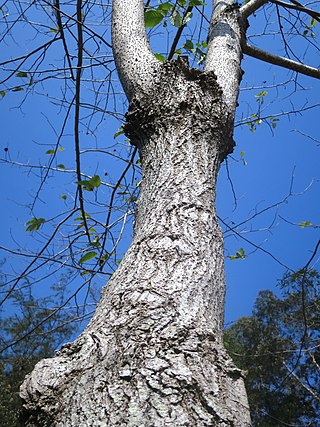
Camptotheca is a genus of medium-sized deciduous trees growing to 20 metres (66 ft) tall, native to southern China and Tibet. The genus is usually included in the tupelo family Nyssaceae, but sometimes included in the dogwood family Cornaceae.

The blood banana, is a variety of the wild banana Musa acuminata native to Sumatra, Indonesia. The blood banana is an ornamental plant, named for the dark red patches on its leaves, though its small-seeded fruits are also edible. It grows 6' to 8' tall in the wild, but is well-adapted to container growing and can be maintained at 3' to 5'. It grows best in full or partial sun and is hardy in zones 9 - 11.

Musa is one of two or three genera in the family Musaceae. The genus includes flowering plants producing edible bananas and plantains. Around 70 species of Musa are known, with a broad variety of uses. Though they grow as high as trees, banana and plantain plants are not woody and their apparent "stem" is made up of the bases of the huge leaf stalks. Thus, they are technically gigantic herbaceous plants. Musa species are used as food plants by the larvae of some Lepidoptera species, including the giant leopard moth and other Hypercompe species, including H. albescens, H. eridanus, and H. icasia.

Carpentaria acuminata, the sole species in the genus Carpentaria, is a palm native to tropical coastal regions in the north of Northern Territory, Australia.

Gros Michel, often translated and known as "Big Mike", is an export cultivar of banana and was, until the 1950s, the main variety grown. The physical properties of the Gros Michel make it an excellent export produce; its thick peel makes it resilient to bruising during transport and the dense bunches that it grows in make it easy to ship.
Chevreulia lycopodioides, the clubmoss cudweed, is a species of flowering plant in the family Asteraceae. It is found only in Falkland Islands. Its natural habitats are temperate shrubland and temperate grassland.
Jardinella acuminata is a species of small freshwater snails, aquatic gastropod mollusks in the family Tateidae.
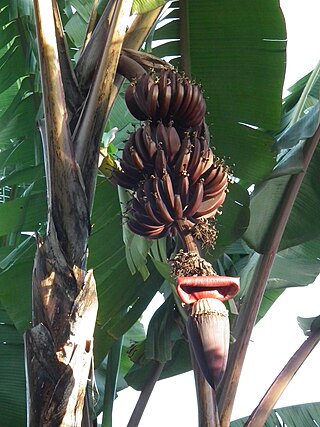
Red bananas are a group of varieties of banana with reddish-purple skin. Some are smaller and plumper than the common Cavendish banana, others much larger. When ripe, raw red bananas have a flesh that is cream to light pink in color. They are also softer and sweeter than the yellow Cavendish varieties, some with a slight raspberry flavor and others with an earthy one. Many red bananas are exported by producers in East Africa, Asia, South America and the United Arab Emirates. They are a favorite in Central America as a form of aphrodisiac juice, along with being a favourite in India in order to promote fertility but are sold throughout the world.

Musa acuminata is a species of banana native to Southern Asia, its range comprising the Indian Subcontinent and Southeast Asia. Many of the modern edible dessert bananas are from this species, although some are hybrids with Musa balbisiana. First cultivated by humans around 10 kya, it is one of the early examples of domesticated plants.

The Blue Java is a hardy, cold-tolerant banana cultivar known for its sweet aromatic fruit, which is said to have an ice cream-like consistency and flavor reminiscent of vanilla. It is native to Southeast Asia and is a hybrid of two species of banana native to Southeast Asia — Musa balbisiana and Musa acuminata.
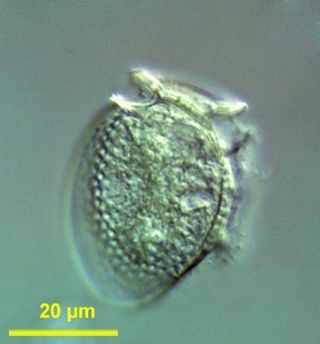
Dinophysis is a genus of dinoflagellates common in tropical, temperate, coastal and oceanic waters. It was first described in 1839 by Christian Gottfried Ehrenberg.
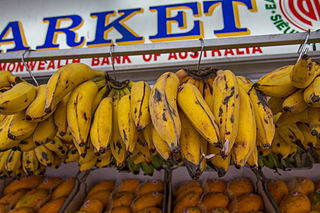
Lady Finger bananas are diploid cultivars of Musa acuminata. They are small, thin skinned, and sweet.

The Latundan banana is a triploid hybrid banana cultivar of the AAB "Pome" group from the Philippines. It is one of the most common banana cultivars in Southeast Asia and the Philippines, along with Lacatan and Saba bananas. Its Malaysian name is pisang rastali.

Lakatan bananas, also spelled Lacatan, are diploid banana cultivars from the Philippines. It is one of the most common banana cultivars in the Philippines, along with the Latundan and Saba bananas.
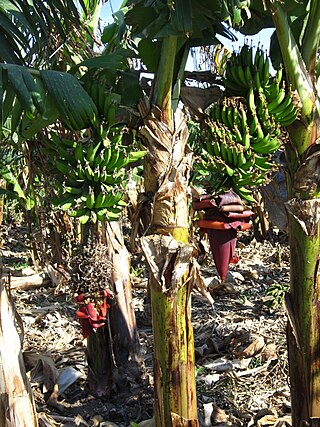
Musa × paradisiaca is the accepted name for the hybrid between Musa acuminata and Musa balbisiana. Most cultivated bananas and plantains are triploid cultivars either of this hybrid or of M. acuminata alone. Linnaeus originally used the name M. paradisiaca only for plantains or cooking bananas, but the modern usage includes hybrid cultivars used both for cooking and as dessert bananas. Linnaeus's name for dessert bananas, Musa sapientum, is thus a synonym of Musa × paradisiaca.

Persoonia acuminata is a plant in the family Proteaceae and is endemic to New South Wales. It is a spreading or prostrate shrub with relatively small leaves and cylindrical yellow flowers arranged singly or in groups of up to sixteen in leaf axils or on the ends of the branches. It grows in moist forest on the higher parts of the tablelands.
















